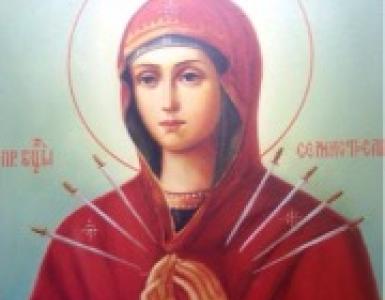Treviso on the map of Italy. Map of the province of Treviso with cities
In front of you detailed map Provinces of Treviso with names of cities and towns in Russian. Move the map while holding it with the left mouse button. You can move around the map by clicking on one of the four arrows in the upper left corner. You can change the scale using the scale on the right side of the map or turning the mouse wheel.
What country is the Province of Treviso in?
The province of Treviso is located in Italy. This is wonderful a nice place, with its own history and traditions. Coordinates of the Province of Treviso: north latitude and east longitude (show on large map).
Virtual walk
The “man” figurine above the scale will help you take a virtual walk through the cities of the Province of Treviso. By clicking and holding the left mouse button, drag it to any place on the map and you will go for a walk, while inscriptions with the approximate address of the area will appear in the upper left corner. Select the direction of movement by clicking on the arrows in the center of the screen. The “Satellite” option at the top left allows you to see a relief image of the surface. In the "Map" mode you will have the opportunity to get acquainted in detail with the roads of the Province of Treviso and the main attractions.
Italy is an extremely rich country in interesting places and beautiful cities. It has access to the Mediterranean and Adriatic seas and a huge number of attractions that are a legacy of the Roman Empire and the Middle Ages. One such interesting city for tourists is Treviso.
general information
Treviso (Italy) is located in the northeast of the country, in the region of Venice. It is the center of the province of the same name. The city is located at the confluence of two rivers, called Botteniga and Sile.
The city has a long history that dates back to Roman times. In those days, the settlement had the name Tarvisium, associated with the Celtic tribe that then inhabited the surrounding lands. In the Middle Ages, Treviso was part of the Venetian Republic and for a long time fought with the neighboring Scaligers. During World War II, the city suffered greatly from air raids during the Allied liberation from German forces.
Treviso from above
The language of communication in the city is Italian. The population is 83 thousand people who live on an area of 55 square kilometers. The leader of Treviso, or the so-called burgomaster, is elected by local residents.
Weather and climate
Treviso is located in a humid subtropical climate with mountain elements. It has hot and humid summers and relatively warm and mild winters. Winters have virtually no snow; it falls extremely rarely and melts quickly.
Important! The best time to visit Treviso is from mid-spring to the end of September, when the weather remains warm and there is virtually no precipitation.
Average temperature and precipitation monthly:
- January - 3.2 °C, 62 mm - precipitation;
- February - 4.9 °C, 69 mm;
- March - 7.9 °C, 82 mm;
- April - 11.6 °C, 82 mm;
- May - 15.4 °C, 97 mm;
- June - 21.3 °C, 65 mm;
- July - 23.6 °C, 67 mm;
- August - 23.3 °C, 93 mm;
- September - 18.3 °C, 67 mm;
- October - 13.5 °C, 104 mm;
- November - 6.7 °C, 96 mm;
- December - 3.5 °C, 63 mm.
Infrastructure
Thanks to a large number tourists and travelers visiting Treviso, the resort infrastructure has received enough high development. The city does not have its own airport; for this purpose, tourists and travelers arrive mainly at Venice Airport, the distance to which is about 22 kilometers. You can get from the airport and other cities and regions of the country using the following types of transport:
- Bus. The most common type of transport in the country. Treviso bus station is located in the city center. This is a fast and comfortable type of transport, all buses are equipped with air conditioning and everything necessary;
- Railway transport. Trains run to Treviso from all major cities in the country. Most often you have to get to Venice and change to a bus;
- Taxi. One of the most convenient types of transport for moving around the city and getting from the airport;
- Transfer. Most tourists and travelers with package tours already travel using transfers. If the transfer has not been pre-booked, you must go to the special window in the arrivals hall. Some managers know Russian;
- Rent a Car. The most convenient and quick view moving between cities and attractions. You can rent a car directly at the airport or any other point within populated areas.
Note! You cannot hail a taxi on the streets of Treviso. To do this, you need to call a car by phone or look for a special taxi parking lot.
Sights and excursions
The main attractions of the city are located within the old center, which was previously a fortress and was surrounded by walls. The length of the walls is about four kilometers and this moment Three entrance gates have been preserved. They are called respectively the gates of St. Thomas, the Forty Saints and the Altinius.

Gate of St. Thomas
The city of Treviso in Italy, attractions (description):
- Piazza Dei Signori. It is the main and central square of the city. All festivals, holidays and significant events in the life of the city and local residents take place here. The oldest building is a 13th century palace called Palazzo dei Trecento. Built in the Romanesque style, the building attracts crowds of tourists and travelers and is an iconic place in the city.
- Duomo Cathedral. Located in the central square, directly opposite the palace. This religious building was built in the 13th century and is famous for its beautiful chapel and frescoes, which were made by the best craftsmen of those times.
- Church of San Nicolo. The church, made in a mixture of Gothic and Romanesque styles, was also built in the 13th century. People come here to admire the famous frescoes, which were made by the famous and popular master of that time, Tomazzo da Modena. Here are the burial places of Dante's son and Petrarch's daughter. It is a popular tourist spot and a gathering place for local residents.
- Vicolo Molinetto area. A very beautiful place, which is distinguished by a picturesque park, ideal for walking, and a windmill, which continues to operate today.
- Loggia of the Knights. The monument, which is located in the very center of the city and is famous for its very ancient frescoes depicting knights from different eras. The building was built in the second half of the 13th century, recently underwent restoration and gained a second glory.
Recreation and entertainment
Among the places for recreation and entertainment, one can highlight the island of Pescaria, which is an excellent place for shopping. All the most popular shops and shopping centers in the city are located here. The place is also rich in cafes, bars and restaurants. In restaurants, it is recommended to try the fresh seafood for which the region is famous.
Location on the map
Treviso is quite easy to find on the map; it is located in the northeast of Italy, not far from Venice. The settlement lies on the banks of two rivers in a very picturesque place.

Location of Treviso on the map of Italy
Interesting facts and useful information about the city
Some interesting facts and information about Treviso include the following:
- Treviso is the birthplace of the popular dessert teramisu;
- The patron saint of the city is Saint Liberalius of Ancona; his day is celebrated on April 27;
- The city is home to the headquarters of famous global corporations such as the Benetton group and De’Longhi.
Treviso is a popular tourist city with many attractions and places of interest. It is located near Venice, which you can easily visit along the way.
Treviso- a small town 30 km north of, not far from. Treviso is the birthplace of the popular tiramisu cake, which was created at Ristorante le Beccherie in Piazza Ancillotto.
Treviso is often called “Venice in miniature,” and to some it resembles Amsterdam. Artists, photographers and film directors love to come here - and wherever the local rivers and canals, bridges and embankments, small waterfalls and water mills, houses and palaces reflected in the greenish surface of the water are captured.
The lack of stone in the vicinity of Treviso affected the external appearance of the city: there are few buildings decorated with sculpture, but many (up to five hundred) external frescoes have been preserved in good condition. On the streets and squares you can see both fragments of ornaments on window openings or entrance portals, and huge plot works covering the façade with a carpet. Allegorical images and mythological subjects were especially popular; today the imagination of painters is not limited by anything.
The name of the city of Treviso most likely comes from the Latin tre visi - “three peaks”. Indeed, the city stands on three hills, on which there are three squares: Duomo (Cathedral), Signori and San Leonardo.
One of the bridges over the Sile River is named after Dante Alighieri ( Ponte Dante). The great Florentine poet mentioned Treviso in " Divine Comedy”, calling it the place “... where Sile and Kanyan merge.”
Get there:
By plane:
- The nearest airport is Venezia (Treviso) Airport (TSF), where many low-cost airlines such as Ryanair fly.
- From the airport in Treviso: to Treviso Centrale central station - bus 6.
By train:
- Treviso is located on the train line between Venice and Udine.
- To Venice: about half an hour drive, 30 km, €3.
By car:
Toll highways:
- A4 - - - -Trieste
- A13 - -
- Scenic road SS13 to Venice: beautiful landscapes and ancient villas. Ideal for a cycling route.
Around town:
- It's best to walk. City buses cost €1 within Treviso and €1.50 outside.
Get your bearings:
Treviso is located at the confluence of the Cañan River and the Sile River, the latter crosses the city from west to east. Treviso has three central squares - piazza del Duomo (Piazza Duomo), piazza dei Signori (Piazza Signori, the very center of the city) and piazza San Leonardo (Piazza San Leonardo).
From railway station in the north of the city need to go through via Roma (via Roma) past the bus station, cross the bridge from which a beautiful view opens, and, walking along corso del Popolo (Corso del Popolo) to piazza del Borso (Piazza del Borso), go downstairs.
“Treviso card”- €12/24 hours, €17/48 hours and €22/72 hours - free public transport and entry to museums, Palladian Villa Emo in Fanzola di Vedelago, Villa Barbaro in Maser and Canova Museo Gipsoteca in Possagno.
History of Treviso:
Ancient Celtic settlement in the 2nd century BC. the settlement became part of the Roman Republic. Since that time, the layout of the city has been preserved.
In 477 Treviso was captured by the Goths. In the 12th century, the city achieved relative independence, and in 1164, Frederick Barbarossa granted Treviso some privileges, including the right to decorate homes with standards with city symbols - a silver cross on a red background and two eight-pointed gold stars. Since 1176, the supreme power in the city was exercised by the podestà, appointed by the city council.
Representatives of the Scala dynasty (Scaligers) seized power in Treviso in 1329 and ruled until 1338, when the Podesta of Marin Fallero (the future Doge of Venice) was appointed to the city. In Treviso, he became famous as the organizer of the Palio equestrian competition on St. Day. Nicholas. The races took place on the streets of the city, connecting three squares (Cathedral Square, Piazza Signori and Piazza San Leonardo). Anyone wishing to take part in the competition was required to notify the podesta in advance and present the declared horse for inspection. The winner of the race received the Palio challenge banner, the rider who arrived second received a falcon, the third received a rooster, and the last received a shameful award in the form of a pig's head. These equestrian competitions are still held, several times a year they are organized by the municipality, private individuals and even the church.
Attractions:
Ancient frescoes on the facades of the palazzo:
While traveling around the city, you should pay attention to the ancient frescoes that decorate
- Ca-dei-Rikki (Ca' dei Ricchi), Via Barberia, 25
- small palace from the 16th centuryvia Collalto,
- house on via Palestro, 35,
- house with a Renaissance loggia onvia Fiumicelli,
- house from the 16th century via Canova, 38,
- Kaza- distance- Corno(Casa dal Corno) on piazza del Duomo
- and several houses near Dante Bridge.
Piazza del Duomo and Cathedral
Piazza del Duomo It was also loved by the ancient Romans. An ancient temple stood here, later it was replaced by an early Christian one baptisterySan- Giovanni(Battistero di San Giovanni), later rebuilt (the late antique floor mosaic was preserved). CathedralCathedral(Duomo) built in the 18th century.
Palazzo dei Trecento
On piazza dei Signiori worth it palazzoTrecento(Ralazzo dei Trecento), a wonderful example of architecture of the 13th century (in fact, the Italian word “trecento” means “XIII century”). The Guelph government met in the palace, and since 1553 the residence of the Podesta was located.
Over the course of 800 years, the palace was rebuilt several times; now the lower floor houses shops of leading Italian fashion brands. The large hall of the palazzo is used as a conference room and the main exhibition hall of the city.
- Palazzo Trecento
- Piazza dei Signiori
- Mon–Fri 07.30–12.00 and 15.30–19.00, Sat, Sun 07.30–13.00, 15.30–20.00
Located nearby Prefectural Palace(Palazzo della Prefettura), Palazzo Pretorio(Palazzo Pretorio) And City Tower(Torre Civica).The square is full of people at almost any time of the day, but especially in the evening - people come here to sit with a glass of wine and chat, enjoy ice cream, and find out the latest news.
Piazza San Leonardo
On piazza San Leonardo there is a church San Leonardo(Chiesa di San Leonardo) and interesting Spineda mansion(Palazzo Spineda, XVI century, reconstructed in the XVIII century) - a typical example of an aristocratic dwelling of the Renaissance. It now houses the administration of the province of Treviso. Fountain, standing opposite the building, used to decorate the palace park.
La Pescheria
Between the two branches of the Grand Cañan there is the islet of Pescheria, which occupies an ancient fish market(La Pescheria). It appeared in 1855, when pedestrian bridges were built. Every day at 7 o'clock in the morning, fish and seafood dealers come here. There are several medieval and modern buildings nearby. One of the main decorations of the market is the wheel of a water mill.
Fontana delle Tette
In the courtyard home da Noal (Casa da Noal) on via Canova (via Canova) installed Tette fountain(Fontana delle Tette, 1559). The slang name translates as “fountain of tits,” and the magnificent forms of the white-faced sculpture decorating the fountain confirm that the nickname is fair. The fountain was installed in honor of the victory over the Venetian Republic. They say that for the first three days after the opening of the fountain, grape wine flowed from the statue’s breasts; now there are two streams of drinking water.
An exact copy of the fountain made of Istrian stone was installed in the Gallery on strada Romana (Roman's suffering).













